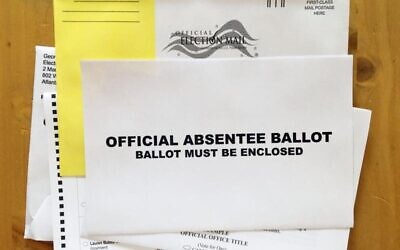What You Should Know About the 2020 Election
On Nov. 3, the folks who administer elections in Georgia hope to avoid a repeat of the problems that plagued the June 9 primary and sullied the state’s reputation.
Dave Schechter is a veteran journalist whose career includes writing and producing reports from Israel and elsewhere in the Middle East.
On Nov. 3, the folks who administer elections in Georgia hope to avoid a repeat of the problems that plagued the June 9 primary and sullied the state’s reputation.
The televised images included hundreds of people standing in line waiting to vote, polling stations kept open past the closing hour to accommodate people already in line, insufficient numbers of machines in some places, machines with technical problems in others, and poll workers uncertain of procedures.
Reports that just weeks before the general election, the state is fixing a software problem in its new, $104 million voting machines, combined with concerns about the handling of an anticipated record number of absentee ballots, have done little to lesson anxieties.
Turnout by the state’s more than 7.4 million voters could approach the record 75.6 percent of eligible voters who cast ballots in the 2016 presidential election. State officials have suggested that as many as 1.5 million absentee ballots may be filed, with another 2 million people taking advantage of in-person early voting, and 2 million expected to vote on Election Day.
To help you with the nuts and bolts of the election, here are some basic how-tos:
Dates to Remember
The deadline to register to vote in the general election was Oct. 5. Early voting began Oct. 12 and runs through Oct. 30.
On election day, about 2,500 polling places will open at 7 a.m. and close at 7 p.m., unless circumstances warrant keeping open individual locations, as was done in the primary.
Any runoffs necessary for state and local offices will take place Dec. 1 and for federal offices Jan. 5. A runoff is likely in one of two U.S. Senate races and possible in the other.

Absentee Ballots
More than 1.15 million people voted absentee in the primary, totaling nearly half the ballots cast. Slightly more than 14 percent of the primary ballots were cast in early voting and more than 37 percent on June 9.
For the general election, the state did not send absentee ballot applications to all registered voters, as it did in advance of the primary. Still, by Oct. 7, more than 1.5 million people had applied for absentee ballots, including through an online portal the secretary of state’s office unveiled in August. The state also created an online tracking system for people to track the progress of their application.
According to data compiled at Georgia Votes, as of Oct. 5, the majority of absentee ballot applications statewide came from whites (53.1 percent, as well as 30.8 percent from African-Americans) and women (56.9 percent), with shy of half (44.8 percent) from voters age 65 and older. Of note, 30 percent came from people who did not vote in 2016 and 28.6 percent from people who did not vote in 2018.
Absentee ballots can be mailed back to county election offices, taken to county election offices, or dropped off at designated lock-box locations. As this article was written, the deadline for return of absentee ballots had been restored to 7 p.m. Nov. 3, as the 11th Circuit Court of Appeals overruled a lower court ruling that would have required counting ballots postmarked by Nov. 3 but received later. Now, absentee ballots mailed too close to Election Day could be disqualified if they arrive after the deadline.
The state has given the counties a green light to begin scanning absentee ballots two weeks and a day before Election Day, but no votes will be tabulated until Nov. 3.
A survey of 1,150 likely Georgia voters — conducted Sept. 11-20 by the University of Georgia’s School of Public & International Affairs for the Atlanta Journal-Constitution – found that 26.7 percent planned to vote by absentee ballot, 36.8 percent in early voting, and 33.9 percent on Election Day.
A Quinnipiac University Poll of 1,125 likely Georgia voters — conducted September 23-27, with a margin of error of 2.9 percentage points – found supporters of President Donald Trump three times more likely than backers of former vice president Joe Biden to vote in person on Election Day (65 percent to 22 percent); Biden’s supporters more than three times as likely to use mail-in/absentee ballots (36 percent to 11 percent) and substantially more likely to vote in person during early voting (41 percent to 23 percent).

Voting Machines
Nov. 3 will be the largest test of the new machines, manufactured by Dominion Voting Systems, which are designed to back up the computer screens with a paper trail, a system that critics say still remains open to tampering. Election integrity activists have appealed to a federal judge, asking that the state not use the new machines and instead use hand-marked paper ballots for the election.
Not that further controversy was needed, but in early October, election officials were applying a software fix to the system, related to the size of the ballot for the all-comers to fill the unexpired two years in the term of retired Republican Sen. Johnny Isakson. There are 21 names on the ballot but not all fit on a single computer screen during testing. Thus, a fix weeks before Election Day.
On June 9, problems were reported in nearly two dozen counties, the epicenter being Fulton County, where waits of several hours were reported at polling places (most notably at the Park Tavern near Piedmont Park), along with missing voting equipment and inexperienced poll workers.
COVID-19 played a role in the large number of absentee ballots cast in the primary. The virus made some regular polling places unavailable and kept home many regular poll workers, who tend to be older members of the population. Various groups have been trying to convince more young people to serve as poll workers in November. The state hoped to recruit 25,000 people for this duty. In addition to increased training for the poll workers, the state plans to add additional voting machines and ballot scanners at polling places.

Voting Demographics
Nationally, more than half (56 percent) of those voting in 2016 were age 50 and older, according to the Pew Research Center. Jewish turnout in presidential elections nationally hovers around 80 percent. The Jewish Electorate Institute says that 29 percent of Georgia’s Jewish population is age 65 and older, compared with 19 percent of the state as a whole. Given the propensity of both Jews and older people to vote in percentages greater than the population in general, the votes of older Jews could help sway the balance in close races, such as the state’s two Senate seats.
Voters under age 25 make up the fastest-growing segment of the electorate, doubling from 6 percent in 2016 to 12.3 percent in 2020, according to the secretary of state’s office.
Voters under age 35 comprise 31 percent of the electorate, compared with 23 percent in 2016, according to an analysis by the AJC. At the other end of the age spectrum, the percentage of voters older than 65 declined from 24.3 percent in 2016 to 19.3 percent in 2020.
The secretary of state’s office reported in February that 52.9 percent of registered voters self-identified as white, down from 56.7 percent in 2016. The African American percentage of 29.6 in 2020 was a fraction less than the 30 percent in 2016. Hispanics numbered 3.3 percent of the 2020 electorate, up from 2.3 percent in 2016, while the Asian Pacific population increased to 2.4 percent in 2020 from 1.8 in 2016. The state reported the racial identification of 10.2 percent to be unknown in 2020.
- Presidential Election
- Donald Trump
- Joe Biden
- Election Day
- Absentee ballots
- Georgia Votes
- Johnny Isakson
- Park Tavern
- piedmont park
- Jewish Electorate Institute
- Dave Schechter
- GEORGIA
- Georgia primaries
- Polling stations
- Voting machines
- 2929 Election
- Eligible Voters
- Ballots
- 11th Circuit Court of Appeals
- Early voting
- Runoffs
- 2020 Presidential Election
- polling places
- politics
- Political
- News




comments